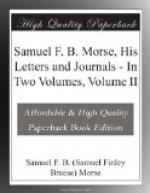But while in his leisure moments he could indulge in such hopeful dreams, his chief care at that time, as stated at the beginning of this chapter, was to earn money by the exercise of his profession. His important painting of the Louvre, from which he had hoped so much, was placed on exhibition, and, while it received high praise from the artists, its exhibition barely paid expenses, and it was finally sold to Mr. George Clarke, of Hyde Hall, on Otsego Lake, for thirteen hundred dollars, although the artist had expected to get at least twenty-five hundred dollars for it. In a letter to Mr. Clarke, of June 30, 1834, he says:—
“The picture of the Louvre was intended originally for an exhibition picture, and I painted it in the expectation of disposing of it to some person for that purpose who could amply remunerate himself from the receipts of a well-managed exhibition. The time occupied upon this picture was fourteen months, and at much expense and inconvenience, so that that sum [$2500] for it, if sold under such circumstances, would not be more than a fair compensation.
“I was aware that but few, if any, gentlemen in our country would be willing to expend so large a sum on a single picture, although in fact they would, in this case, purchase seven-and-thirty in one.
“I have lately changed my plans in relation to this picture and to my art generally, and consequently I am able to dispose of it at a much less price. I have need of funds to prosecute my new plans, and, if this picture could now realize the sum of twelve hundred dollars it would at this moment be to me equivalent in value to the sum first set upon it.”
The change of plans no doubt referred to his desire to pursue his electrical experiments, and for this ready money was most necessary, and so he gladly, and even gratefully, accepted Mr. Clarke’s offer of twelve hundred dollars for the painting and one hundred dollars for the frame. Even this was not cash, but was in the form of a note payable in a year! His enthusiasm for his art seems at this period to have been gradually waning, although he still strove to command success; but it needed a decisive stroke to wean him entirely from his first love, and Fate did not long delay the blow.
His great ambition had always been to paint historical pictures which should commemorate the glorious events in the history of his beloved country. In the early part of the year 1834 his great opportunity had, apparently, come, and he was ready and eager to grasp it. There were four huge panels in the rotunda of the Capitol at Washington, which were still to be filled by historical paintings, and a committee in Congress was appointed to select the artists to execute them.
Morse, president of the National Academy of Design, and enthusiastically supported by the best artists in the country, had every reason to suppose that he would be chosen to execute at least one of these paintings. Confident that he had but to make his wishes known to secure the commission, he addressed the following circular letter to various members of Congress, among whom were such famous men as Daniel Webster, John C. Calhoun, Henry Clay, and John Quincy Adams, all personally known to him:—




